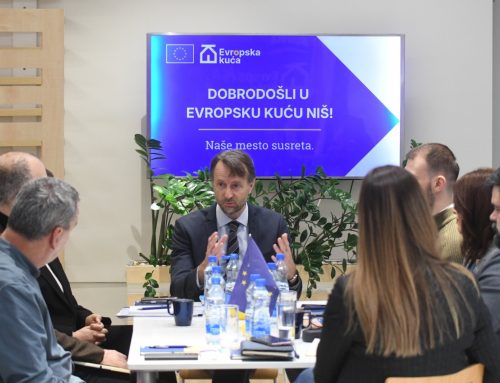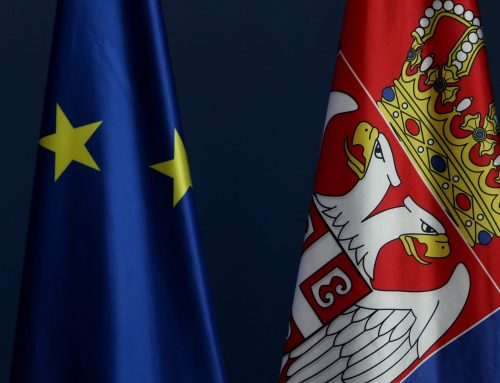The winners of the 2018 EU Prize for Cultural Heritage / Europa Nostra Awards, Europe’s top honour in the field, were celebrated this evening during a high-profile awards ceremony in Berlin, in the presence of the Federal President of Germany Frank-Walter Steinmeier. Maestro Plácido Domingo, President of Europa Nostra, the leading European heritage network, and Tibor Navracsics, European Commissioner for Education, Culture, Youth and Sport, co-hosted the European Heritage Awards Ceremony. They announced and presented the 7 Grand Prix laureates, chosen from among this year’s 29 winners recognised for their impressive achievements in the area of heritage preservation, heritage research, dedicated service, and education, training and awareness raising, among which is the project of conservation of the Fortress in Bac in Serbia. The Ceremony is among the highlights of the first ever European Cultural Heritage Summit, one of the key European events of the European Year of Cultural Heritage 2018, which is taking place in Berlin from 18-24 June.
The 7 Grand Prix laureates, selected by a jury of experts and entitled to receive €10,000 each, are:
Category conservation
- Dr. Barner’s Sanatorium, Braunlage/Harz, GERMANY
- Byzantine Church of Hagia Kyriaki, Naxos, GREECE
- The Bač Fortress, Bač, SERBIA
Category research
Category dedicated service
- Mrs. Tone Sinding Steinsvik, NORWAY
- Private Water Owners of Argual and Tazacorte, Canary Islands, SPAIN
Category education, training, awareness raising
The Public Choice Award went to the rehabilitation of the Botanical Garden of the National Palace of Queluz, Sintra, Portugal. Some 6,500 people voted for their favourite heritage achievements in Europe via an online poll conducted by Europa Nostra.
During the Ceremony, the EU Prize for Cultural Heritage / Europa Nostra Awards 2018 were presented to 29 winners from 17 countries taking part in the EU’s Creative Europe programme. In addition, a remarkable heritage achievement from Turkey, a European country not participating in that programme, also received a Europa Nostra Award.
Plácido Domingo, the renowned opera singer and President of Europa Nostra, stated: “It has been an enormous joy and privilege to meet our Award winners in Berlin and to celebrate their achievements together with so many Europeans dedicated to culture and cultural heritage. I warmly congratulate all the winners, particularly the Grand Prix laureates and the Public Choice Award winner. They are superb examples of organisations and individuals who care and work to safeguard our shared heritage.”
The President of Europa Nostra added: “The first ever European Cultural Heritage Summit in Berlin has brought together heritage champions, networks and experts; artists and journalists; high-ranking decision-makers acting at local, regional, national and European level as well as many civil society organisations and citizens. Our Summit has been a unique occasion to demonstrate our firm readiness to join forces to build a future Europe based on and inspired by the beauty and variety of our shared heritage and shared values.”
Tibor Navracsics, European Commissioner for Education, Culture, Youth and Sport, said: “I congratulate all the winners of the European Union Prize for Cultural Heritage / Europa Nostra Awards 2018 for their remarkable achievements. In showcasing and promoting cultural heritage in all its different forms, they will be a source of inspiration for others and help to build bridges between people from different backgrounds. This is what the European Year of Cultural Heritage is all about, and that is why this year’s ceremony is especially important. At the conclusion of the European Year, the Commission will present an Action Plan for Cultural Heritage to ensure that our shared commitment to preserving cultural heritage remains a top priority on the European Union’s political agenda.”
The Awards Ceremony was attended by some 1,000 people, ranging from high-level officials from EU Institutions and Member States to leading representatives of heritage organisations from all over Europe.
The first European Cultural Heritage Summit “Sharing Heritage – Sharing Values” is co-hosted by the German Cultural Heritage Committee (DNK), the Prussian Cultural Heritage Foundation (SPK) and Europa Nostra. It is supported by the European Commission, the German Federal Government Commissioner for Culture and the Media and the Berlin Senate Department for Cultural Affairs and Europe as well as many German and European partners, associates and private sponsors.
The Bač Fortress, whose construction began in the 14th century with additions made in the 15th and 16th centuries, is a cultural monument of exceptional importance. The project Centuries of Bač was initiated in 2006 to research and increase knowledge about the area of Bač; to implement key conservation principles in its preservation; to find a sustainable use for the site; and to raise awareness of its value among the wider community.
The conservation and rehabilitation of the Bač Fortress has been a central part of this project. The project was carried out by the Provincial Institute for the Protection of Cultural Monuments – Petrovaradin, and supported by its partners: the Fund for Preserving Cultural and Historical Heritage “Centuries of Bač”, the Faculty of Technology of the University of Novi Sad and the Museum of Vojvodina. The project received financial support from regional, national and international sources including EU funding.
The project has successfully integrated the Bač Fortress into the life of the local community and has found a sustainable use to ensure its future. It has been restored, its archaeological remains preserved and its interior transformed into a visitor centre and exhibition space which helps visitors to interpret the wider cultural landscape of Bač. It has also become a centre where professional knowledge about heritage conservation and management is gained, enhanced and shared. For the past 15 years the Fortress has also been the regional central point for the European Heritage Days, an initiative of the Council of Europe. Due to the success of this project the Bač Fortress was listed on UNESCO’s Tentative List in 2010, as a part of the “Historical place of Bač and its surroundings”.
“This project is an exceptional example of heritage preservation based on interdisciplinary collaboration. To achieve this, the project leaders have made use of European resources to research and carry out necessary preliminary investigations, which in turn has led to the implementation of a correct management strategy. A sustained effort has been made to maintain the aspect of the ruin through careful conservation. In addition there is a strong educational component relevant to the entire region”, the jury said.
The town of Bač shows influences of Romanesque, Gothic, Renaissance, Byzantine, Islamic and Baroque styles, along with examples of vernacular architecture. The built heritage pays testimony to the cultural diversity of the area, linking the Balkans with Central and Western Europe. Some of its most iconic structures are now listed as national monuments: namely the Bač Fortress, the Bodjani Orthodox Monastery and the Franciscan Monastery of Bač. “The Fortress is located in close proximity to the Danube, a river which has provided a link between many European countries”, the jury noted.
For more information
EU Heritage Award and Europa Nostra Prize
The EU Prize for Cultural Heritage/Europa Nostra Awards was launched in 2002 by the European Commission and has been organised by Europa Nostra since then. The Prize celebrates and promotes best practices related to heritage conservation, research, management, volunteering, education and communication. This way, it contributes to a stronger public recognition of cultural heritage as a strategic resource for Europe’s society and economy. The Award is supported by the European Union through the Creative Europe programme.
In the past 16 years, organisations and individuals from 39 countries have submitted a total of 2,883 applications for the Awards. Since 2002, independent expert juries have selected 485 award-winning projects from 34 countries. Spain tops the list with 64 awards received. The United Kingdom is in second place (60 awards) and Italy comes third (41 awards). A total of 109 Grand Prix of €10,000 have been presented to outstanding heritage initiatives, selected from among the award-winning projects.
The EU Prize for Cultural Heritage / Europa Nostra Awards has further strengthened the capacity of the heritage sector in Europe by highlighting best practices, encouraging the cross-border exchange of knowledge and connecting various stakeholders in wider networks. It has also brought major benefits to the winners, such as greater (inter)national exposure, follow-on funding and increased visitor numbers. In addition, it has raised awareness of our shared heritage amongst the general public while highlighting its intrinsic European character. The Prize is therefore a key tool to promote Europe’s heritage.
Europa Nostra
Evropa Nostra is a pan-European federation of heritage NGOs, which is supported by a wide range of public bodies, private companies and individuals. Covering 40 countries in Europe, it is the most representative network working in the field and for the field of heritage in Europe. The President of Europa Nostra is the renowned opera singer and conductor Plácido Domingo. Europa Nostra runs campaigns for the preservation of threatened monuments, sites and landscapes in Europe, particularly through its “7 Most Endangered” programme. Also, it celebrates heritage excellence through its EU Heritage Award and Europa Nostra. The organisation actively contributes to drafting and implementation of European heritage-related strategies and policies, through structural dialogue with European institutions and coordination of the European Heritage Alliance 3.3. Europa Nostra is one of the main actors and partners of the 2018 European Year of Cultrual Heritage.
Creative Europe
Creative Europe is the new European Union programme offering support for culture and creative sectors, contributing to an increase in employment and economic growth. With a budget of EUR1,46 billion for the period 2014-2020, the programme supports organisations active in the field of heritage, performing arts, visual arts, multimedia, publishing, cinema, music and TV industry, video games, contributing to the work of tens of thousands of artists and culture workers. The funding schemes ensure cooperation among actors from across Europe to cooperate, reach new audiences and develop skills necessary for the digital age.




